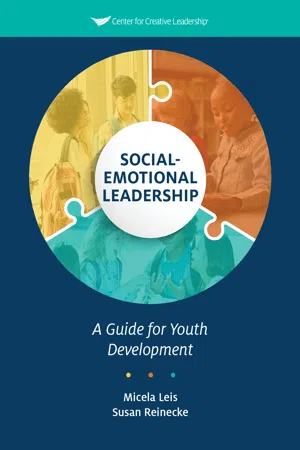
- 182 pages
- English
- ePUB (mobile friendly)
- Available on iOS & Android
eBook - ePub
Social-Emotional Leadership: A Guide for Youth Development
About this book
Today's youth are tomorrow's leaders. The better they can understand themselves and work effectively with others, the greater impact they can make on the world around them. Based on research from the Center for Creative Leadership, Social-Emotional Leadership: A Guide for Youth Development identifies 14 student leadership attributes and offers tools for adults to use to develop social-emotional leadership in youth inside and outside the classroom.
Frequently asked questions
Yes, you can cancel anytime from the Subscription tab in your account settings on the Perlego website. Your subscription will stay active until the end of your current billing period. Learn how to cancel your subscription.
At the moment all of our mobile-responsive ePub books are available to download via the app. Most of our PDFs are also available to download and we're working on making the final remaining ones downloadable now. Learn more here.
Perlego offers two plans: Essential and Complete
- Essential is ideal for learners and professionals who enjoy exploring a wide range of subjects. Access the Essential Library with 800,000+ trusted titles and best-sellers across business, personal growth, and the humanities. Includes unlimited reading time and Standard Read Aloud voice.
- Complete: Perfect for advanced learners and researchers needing full, unrestricted access. Unlock 1.4M+ books across hundreds of subjects, including academic and specialized titles. The Complete Plan also includes advanced features like Premium Read Aloud and Research Assistant.
We are an online textbook subscription service, where you can get access to an entire online library for less than the price of a single book per month. With over 1 million books across 1000+ topics, we’ve got you covered! Learn more here.
Look out for the read-aloud symbol on your next book to see if you can listen to it. The read-aloud tool reads text aloud for you, highlighting the text as it is being read. You can pause it, speed it up and slow it down. Learn more here.
Yes! You can use the Perlego app on both iOS or Android devices to read anytime, anywhere — even offline. Perfect for commutes or when you’re on the go.
Please note we cannot support devices running on iOS 13 and Android 7 or earlier. Learn more about using the app.
Please note we cannot support devices running on iOS 13 and Android 7 or earlier. Learn more about using the app.
Yes, you can access Social-Emotional Leadership: A Guide for Youth Development by Micela Leis,Susan Reinecke in PDF and/or ePUB format, as well as other popular books in Business & Food Industry. We have over one million books available in our catalogue for you to explore.
Information

LEADING SELF
In order to lead with others, you must first understand how to lead yourself. This includes being aware of your strengths and challenges and being committed to self-improvement. This section includes information about the following leadership attributes:
ATTRIBUTES | DEFINITIONS |
Self-Aware | can describe what makes them who they are |
Accountable | takes responsibility for their actions |
Resilient | keeps trying if they fail at an important goal |
Integrity | stands up for what they believe in |

“Leading Self means that I am self-aware of what is happening and how I feel. It means that I am growth-minded and open to new ideas. It means that I am motivated in what I do. It means that I am resilient. It means that I am accountable.”
– Middle School Student
Chapter 1
SELF-AWARE

“Being self-aware is being able to control what you say and who you say it to.”
– Eighth Grade Student
“I am aware of both my negative and positive qualities and the areas where I am capable and the areas where I need help.”
– 12th Grade Student
Introduction
Use the information in this section to help you introduce the “self-aware” attribute to students. You can use the question stem “How does this attribute make you a better leader?” to start a discussion with your students and to check for comprehension (see Additional Resources in this chapter for more information to further your personal understanding).
Explaining “Self-Aware” to Students
We all have a mental picture of ourselves—what we believe, how we treat others, what we are good at, and what we may not be so good at. But do you see yourself as others see you? If you asked someone else to describe you, could you accurately predict what that person would say? To be self-aware means understanding who you are, your strengths, and areas in which you can improve. It’s important to understand not only how we see ourselves but also how others see us. Why do you think that is? One reason is that if you understand the areas in which you need to improve, you can ask for help in these areas from other people. Asking for help will allow you to build relationships and work well with others, which is very important for leadership.
What “Self-Aware” Looks Like
Self-aware leaders:
• have an accurate picture of their strengths and weaknesses
• are aware of their feelings
• reflect on and learn from experience
• seek feedback to improve
• are open to criticism and can hear feedback without getting defensive
• work on what they need to learn
• respond well to new situations that require them to stretch and grow
• know what their values are and why they are important to them
• are seen as authentic, attentive, thoughtful, responsive, reflective, and observant
• know how their actions affect others
• adjust their behavior to suit circumstances
What Gets in the Way?
When you are not self-aware, you might see yourself differently than others see you. This may lead to your misreading different situations and not acting appropriately. Your actions can contribute to confusion, frustration, and feelings of being misunderstood. Review the following list and note the items that might give you trouble developing self-awareness.
• You don’t take time to think about how your actions may affect others.
» (Examples: gossiping, bullying, not sharing, taking someone else’s things, etc.)
• You don’t want others to give you feedback.
• You don’t believe you have any room for improvement.
• You think your needs are more important than anyone else’s.
• You respond defensively to feedback.
• People are afraid to tell you things because they don’t want to hurt or offend you.
• You act as if you are someone you are not.
• You have a hard time accepting compliments or positive feedback.
Being able to recognize the positive and negative impact that your words and actions have on others will make you a better social-emotional leader.
Suggestions for Improving “Self-Aware”
Work with your students to discuss and establish some ways to build competency in this attribute. Below is a list to help support this exercise. We encourage you to develop your own strategies or modify these suggestions.
You might also consider doing an activity with your students (see this chapter’s Activity Center for suggestions) or asking them to write about the attribute (see Journal Prompts for suggestions) to help build their understanding. Support is an important part of development, so discuss with your students how you can support each other, as a group or class, to build skill in this leadership attribute.
• Check your awareness. List the characteristics or descriptions of how you hope others see you. For example: kind, considerate, respectful, fun to be around, optimistic, hard-worker, stands up for what you believe in, dependable. Then, ask your accountability partner to write out a list of how they see you. Compare the lists. If your lists do not match, think about ways that you can act that show how you want others to see you.
• Reflect on your personal values. What do you value the most? Where are you willing to compromise? Some of your values are more important to you than others. Think about how your values compare to the values of your family, friends, school, and community.
• Notice how others respond to your actions. If other people respond to your actions in unexpected ways, use that information to think about where your self-awareness may be lacking. Journal about what you might be doing or not doing that might lead to these unexpected responses. Ask a trusted friend or family member for feedback.
• Ask for feedback, and think of it as a gift. What other people tell you about how they see you will help you be more self-aware. Ask others for feedback, listen without being defensive, thank the people who give you feedback, and think of how you can use the feedback to change your actions.
• See change as an opportunity. You can change the beliefs others hold about you and the expectations that they have for your behavior. To make these changes, work on your actions, your approach to different situations, and your understanding about what others need.
• Note how you respond in times of stress. How do you act when you are feeling a lot of pressure or when you are in stressful situations? Every difficult situation or challenge is an opportunity for you to reflect on your experience and grow from it. Take time to think back on the activities of your day, the actions you took, and the choices you made. Decide what changes you can make to react differently in the future.
Activity Center
Here are some suggested activities you can modify to fit your context and the students with whom you work.
• Book introduction. Find a book to read with students that has a character who either demonstrates the “self-aware” attribute or who would have benefitted from being more self-aware, and have students discuss or journal about the character’s behavior (see the Suggested Books section of this chapter for some books that fit this activity).
• Verbal self-portrait. Ask students work with a partner to use words to create a portrait of how they see themselves in terms of their values or actions and how they see their partner (for example: kind, considerate, helps others when they are sad). After they’ve shared their portraits with each other, ask students to divide a piece of paper in half by drawing a line and to create two more self-portraits with words. One of these self-portraits should reflect the title, “This is who I am,” and the other, “This is who I want to be.” Ask students to think about whether they were surprised about anything their partner wrote about them.
• Monologue or poem. Ask students to write a poem or a monologue titled either “This is Who I Am” or “This is Where I Come From” to share with the class. For an example, see George Ella Lyon’s poem “Where I’m From,” which you can access at: http://www.georgeellalyon.com/where.html.
• Johari window. Give students (recommended for students age 16 and older) the Johari Window activity (p. 23). Have t...
Table of contents
- Cover
- Title Page
- Copyright
- Contents
- Introduction
- Part 1: Leading Self
- Part 2: Leading with Others
- Part 3: Changing Your World
- Conclusion
- About the Authors
- Acknowledgments
- About the Center for Creative Leadership